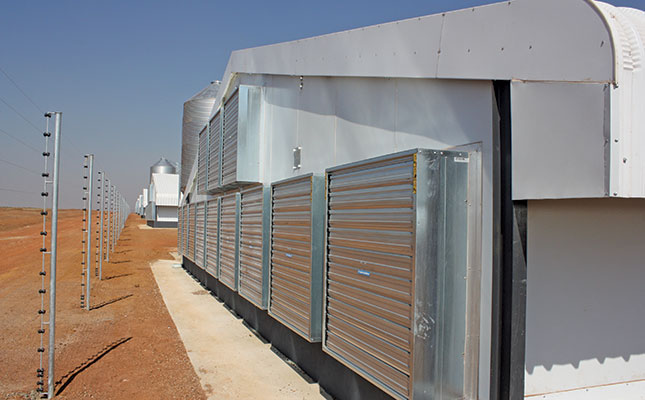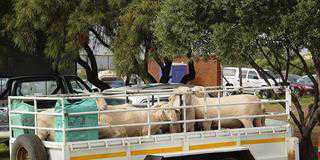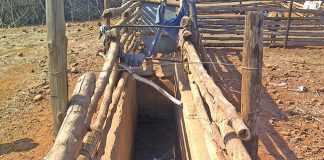
Maintaining the correct temperature in chicken houses can boost your profits, as birds can only perform optimally under comfortable climatic conditions.
The ideal air temperature is between 20°C and 25°C, says Alan Saunders of the SA Poultry Association’s animal welfare committee. “If the temperature is lower than 15°C, adult chickens are likely to survive, but their feed intake will be much higher.
Once you reach temperatures of 25°C to 30°C, egg quality declines, eggs are smaller, feed intake decreases and so does production. “Increase the temperature further and chickens could stop eating altogether and die.” The size of the house – and the farmer’s budget – will determine the type of ventilation system. Saunders suggests that smaller operations could get away with a well-planned, open-sided building. This is cheaper, but it will also mean a loss in the food conversion ratio (FCR) and egg weight. Larger operations require controlled-environment houses, but this bigger investment will be offset by improved FCR and egg weight.
Cage density
Natural ventilation works mainly in low-density, two-tier cage systems found in smaller, narrower buildings. “These houses are generally open and have a lot of air,” explains Saunders.
“As long as the bird density is low, a well-designed natural-ventilation system will work. The only limitation is that there’s no control over the ventilation or the temperature.” By contrast, a building that houses more than 40 000 birds must have a ventilation system. “With such high densities, it’s virtually impossible to ventilate naturally throughout the year, and more control is needed over the air supply,” says Saunders.
Local climate
When considering which ventilation system to install, the local climate must be taken into account:
Highveld. During winter, ventilation in poultry houses should be able to cope with the large, rapid changes between night and day temperatures (0°C to 25°C within six hours). Also, as conditions are dry, moisture needs to be conserved in the houses to reduce dust.
In these areas, summer temperatures are seldom above 35°C, so there is seldom a need for cooling, provided that a good airflow and wind-chill effect is maintained. This is especially the case in high-density houses.
Western Cape: Because of the region’s winter rainfall, the temperature tends to remain low during the day, with long periods below 15°C. An efficient minimum ventilation system (see alongside) is therefore required. In summer, the temperature can be above 35°C and houses require adequate air velocity and air flow over the birds.
Lowveld/KZN coast: Winters are mild, but with high humidity and heat in summer. It is important to have substantial airflow across the birds as this helps to dissipate the heat.
Eastern Cape: Summer temperatures can be very high, often with high relative humidity, especially in the late afternoon when the temperature starts to drop. Cage layer houses require cooling and adequate high air velocity to make use of the wind-chill effect.
Minimum ventilation
According to Saunders, fan-ventilated houses provide minimum ventilation to chickens, supplying sufficient oxygen and removing carbon dioxide. “In this case, the fans must create negative pressure (lower air pressure inside so that fresh air is drawn from the outside),” he explains.
“The distribution of fresh air is also vital; it must be done quickly yet not blasted in at one point. Inlets must be small and plentiful.
“Minimum ventilation can be achieved through a fan jet, as it provides good air distribution, and when the system closes, air is still circulated. This system is high-maintenance, though, and a lot of dust gathers during the cycle.” Side inlets can be used on their own, although this results in low negative pressure as there are too many areas of air leakage.
“It’s imperative for the house to be at 20Pa to 40Pa negative pressure. Side inlets will spread incoming air sufficiently, but farmers must consider having more smaller inlets rather than a few big ones, as this enables better control of negative pressure.”
Intermediate Ventilation
Intermediate ventilation helps to remove heat from the building as the temperature rises. This ventilation is activated when the air in the building reaches a temperature of between 20°C and 25 °C.
Air entering the building through the inlets is then mixed with the existing air in the building, as the fan creates negative pressure. Problems can occur with both minimum and intermediate ventilation systems.
These include having little control over negative pressure, inlets not being controlled in conjunction with fans, and cold and hot spots occurring.
If the inlets are too large and there are not enough of them, cold areas can form where larger volumes of air are introduced.
This is often seen in tunnel ventilation systems. The wind-chill factor must also be taken into account. At the same time, if the main fans are used incorrectly, the air may have to move long distances and stale air can become concentrated.
Email Alan Saunders at [email protected].












